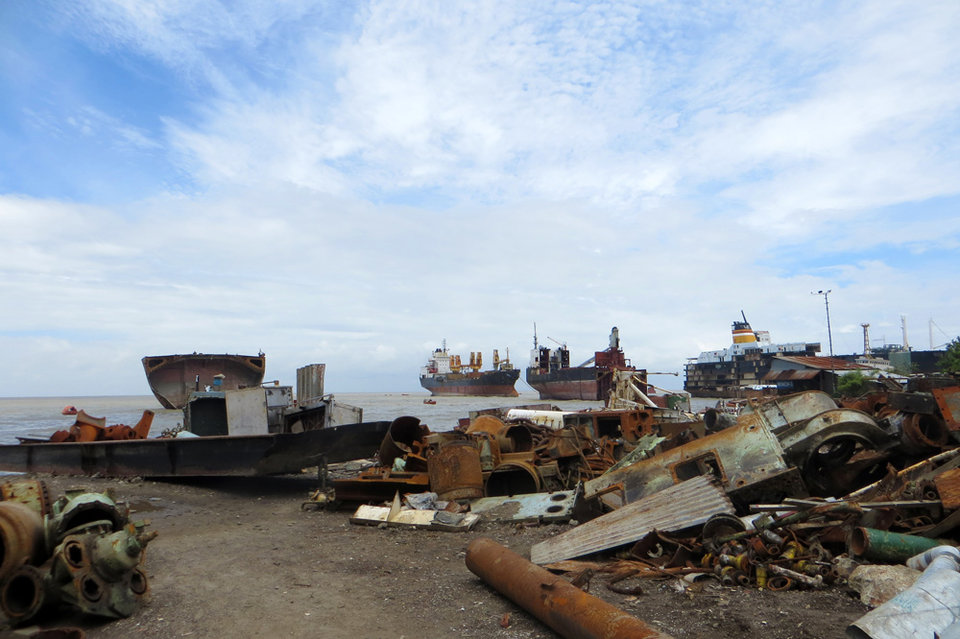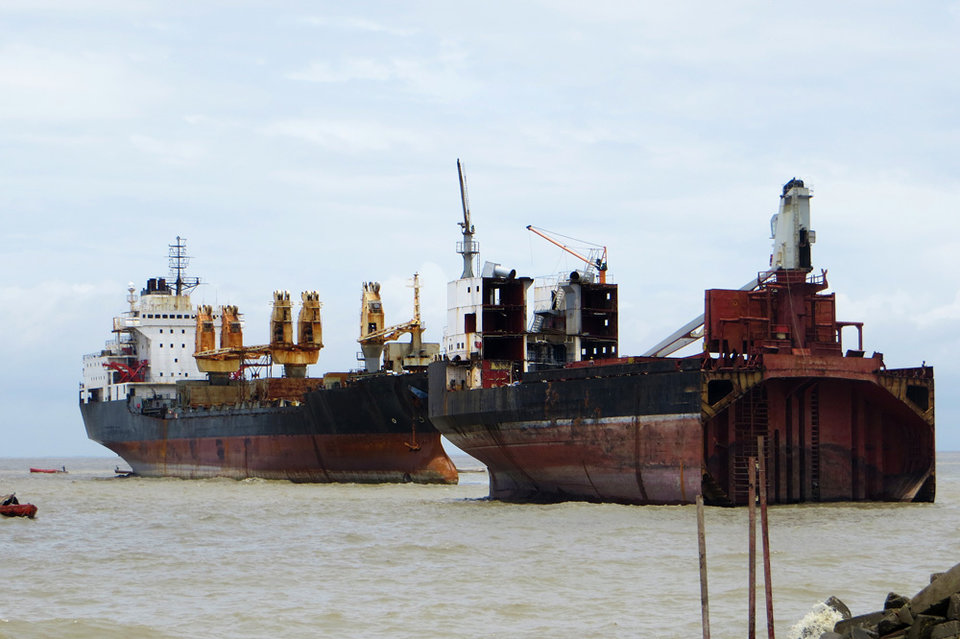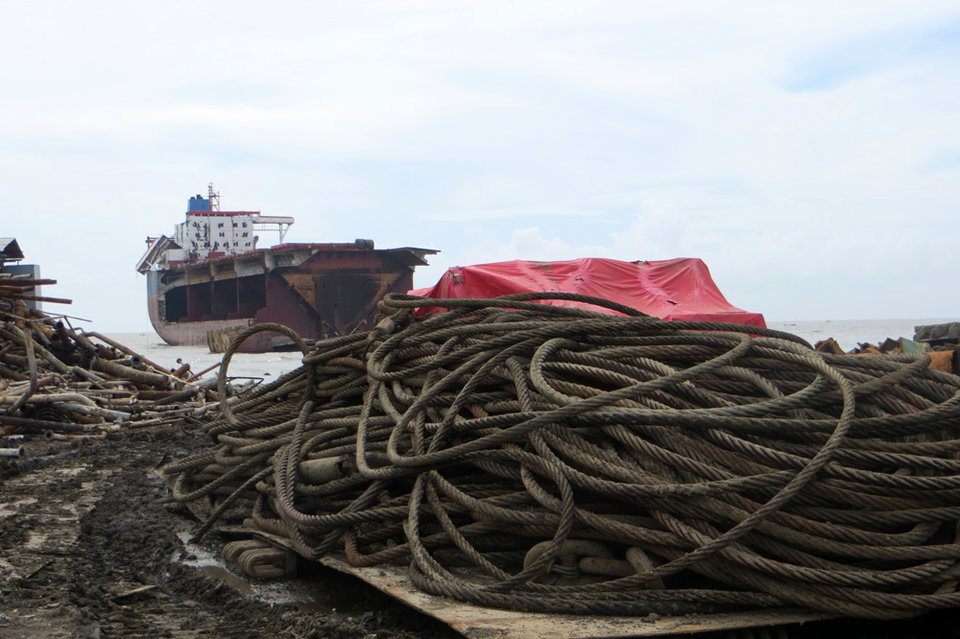Regulation
Dismantling dangerous ship scrapping:
inside the Hong Kong Convention
Germany has become the 13th member of the Hong Kong Convention, the International Maritime Organisation’s treaty covering the safe and environmentally sound recycling of ships – but will the legislation help put an end to dangerous scrapping practices in South Asia? Julian Turner reports.
All images courtesy of IMO
Ceremonial ship
launching, including the now-familiar sight of a bottle of sacrificial champagne being broken over the bow of the vessel as it is named and dispatched, is a centuries-old military tradition.
Such ceremonies typically take place amid considerable fanfare, yet outside the industry much less is known about what happens to commercial ships during the decommissioning process at the end of their operating lives (typically 25-30 years) when they are scrapped, parts are resold or reused, and raw materials such as steel are recycled. Many shipping companies would like to keep it that way.
The controversial practice of ‘beaching’, where ships are sailed onto beaches, often in countries such as India, Pakistan and Bangladesh, and dismantled in the tidal zone, continues to result in fatalities and environmental damage. Workers, some underage, risk serious injury, and exposure to asbestos, heavy metals and flammable gas. Protective clothing and equipment can be absent or inadequate.
According to Shipbreaking Platform, an NGO coalition campaigning for clean and safe ship recycling, in the first quarter of 2019 alone three yard workers died while scrapping merchant vessels on beaches in Bangladesh. A total of 181 vessels were scrapped in Q1, the majority (142) in South Asia.
The environmental toll of beaching includes the release of toxic materials into the local eco-system and, in the Indian sub-continent, the destruction of mangrove forests to make way for ship-breaking.
Shipping companies argue that costs associated with removing asbestos, as well as insurance and health risks, mean that scrapping ships in most developed countries is no longer economically viable.
Stuart Rivers, CEO of Sailors’ Society.
Image courtesy of Sailors’ Society
Toxic colonialism: fighting the export of hazardous materials
The Basel Convention remains a key piece of global legislation aimed at holding governments, shipyard operators and ship owners to account for the safe and responsible dismantling of vessels.
Signed in 1989 and enforced as law in 1992, the multilateral environmental agreement is designed to reduce ‘toxic colonialism’ – namely, the movement of hazardous waste between nations, specifically from developed to less developed countries. As of October 2018, there are 187 parties to the treaty.
In 2004, the Convention was extended to include end-of-life ships, classifying such vessels as “toxic waste” and preventing them from leaving a country without the permission of the importing state.
This had the positive effect of encouraging ship owners to recycle their vessels at facilities in more developed countries, where environmental laws are more likely to be both present and enforceable.
The Hong Kong Convention has yet to be ratified by enough countries to allow it to enter into force
There is also evidence that, when so inclined, Western shipping companies can police recycling practices themselves and, through collaboration, solve the problems associated with beaching.
In Alang, India, for example, Maersk has a representative present at all times during scrapping, who may stop the process if rules are not observed. Since 2016, the Danish line has approved 12 ship-breaking yards in the region that it says meet the group's guidelines for responsible scrapping.
However, environmental groups claim some exporters and countries continue to flaunt the Basel Convention, while the Hong Kong Convention, the IMO treaty covering safe and environmentally sound ship recycling, has yet to be ratified by enough countries to allow it to enter into force.

Image courtesy of
The Hong Kong Convention explained
Adopted at a conference attended by 63 countries in 2009, the Hong Kong Convention covers the design, construction, operation and maintenance of ships, as well as preparation for ship recycling.
It aims to facilitate safe and environmentally sound recycling, without compromising ships’ safety and operational efficiency. Under the treaty, ships sent for recycling must carry an inventory of hazardous materials – such as asbestos, heavy metals and hydrocarbons – specific to each vessel.
In addition, ship recycling yards are required to provide a ship recycling plan, specifying the manner in which each individual vessel will be reutilised, depending on its particulars and its inventory.
In the first quarter of 2019 alone three yard workers died while scrapping merchant vessels on beaches in Bangladesh
At the time of writing, the 13 contracting states to the convention represent 29.42% of world merchant shipping tonnage. This year, Turkey, the Netherlands, Serbia, Japan, Estonia, Malta and, most recently, Germany, have ratified the ruling. Conspicuous by their absence are China and India.
“Asia is the main arena for ship recycling, building and operations,” stated the Asian Shipowners’ Association (ASA) in May. “Therefore, the ASA urges both China and India to promptly ratify the Convention as a key to satisfy the required conditions towards its enactment, for the protection of the global environment.”
According to the IMO, the Hong Kong Convention’s entry into force is expected 24 months after ratification by 15 states, representing 40% of world merchant shipping by gross tonnage, with combined maximum annual ship recycling volume not less than 3% of their combined tonnage.

Image courtesy of

Euro vision: enforcing ethical ship recycling in Europe
So, when will the Hong Kong Convention be enforced and will it be fit for purpose when it finally becomes law? In Europe, authorities are already taking the initiative when it comes to ship recycling.
In January, the EU announced that, from now on, the recycling of all large sea-going vessels sailing under an EU flag can only take place in yards included in the European List of ship recycling facilities.
“For too long, EU vessels have been dismantled in poor environmental and social conditions,” said Karmenu Vella, EU Commissioner for Environment, Maritime Affairs and Fisheries. “This is not acceptable any longer. The full entry into force of the EU Regulation on ship recycling is a milestone for this sector, as it provides for the first time clear and specific rules on how EU-flagged vessels should be recycled.
“Like other recycling activities, ship recycling can be carried out sustainably, in a way which is good for workers, the environment and the economy.”
That certain yards have signed up to this or that convention does not necessarily make it responsible
In 2018, the Norwegian sovereign wealth fund, which invests Norway’s oil income and has shares in shipping giants Maersk and Teekay, decided to offload shares in shipping line Evergreen and several smaller liner companies in Asia after investigating shipbreaking practices in Pakistan and Bangladesh.
In March, Johan Andresen, chair of the fund’s independent Council on Ethics, warned that it is not enough to have papers saying that a yard complies with, for instance, the Hong Kong Convention.
"Many companies have signed up to many things, but we are really only concerned with what they are doing and whether they are making certain that their ships are taken apart in a responsible manner,” he told ShippingWatch.
“We want to make sure that they are responsible all the way to the beach, if you like. That certain yards have signed up to this or that convention does not necessarily make it responsible.”